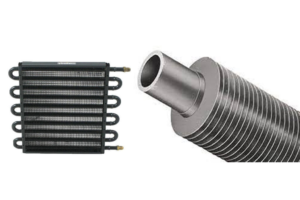Finned tubes are usually used as heat exchanger equipment used in gas & liquid heat exchangers. It accomplishes the purpose of upgrading heat transfer by adding fins to the ordinary base tube. The Fin Tube Heat Exchanger is one of the most successful discoveries in the process of improving tube heat transfer. A finned tube increases the surface area & thus helps in faster heat transfer between the components.
Application of fin tube heat exchanger
Fin tube heat exchangers are used in power, chemical, petrochemical, air conditioning engineering & refrigeration engineering, like surface air coolers, air heaters, & fan coils used in air conditioning engineering. The air cooler evaporator and frost-free refrigerator evaporator utilized in refrigeration engineering are not just appropriate for the flow of single-phase fluid, but also have great value for phase change heat.

Advantages of Using Finned Tubes
-
Increase Heat Transfer Rate
The fins in a finned tube enhance the surface area of contact. This permits it to quicken the heat transfer rate.
-
Improve Heat Transfer Coefficient
In an ordinary tube, the external surface area is just about the same or slightly different from the internal surface area. In such a case, the fluid with the smallest heat transfer coefficient will drive the entire heat transfer rate. A finned tube enhances the surface area fundamentally. This is especially useful when the heat transfer coefficient of the fluid inside the tube is more prominent than that of the fluid external to the tube.
-
Reduces Size of the Equipment & Makes Project Cost Efficient
Finned tubes can essentially expand the surface area. The utilization of a finned tube can cut down the number of tubes used in an application. These outcomes in a considerable decrease in the size of the equipment. In the long run, this can lead to a reduction in the cost of the project.
Selection parameters of fin tube heat exchanger
How to select a Fin Tube Heat Exchanger is indeed a question that consumers need to think about.
Some focus on thermal efficiency & care about whether they can obtain obvious outcomes in a short time; some focus on corrosion resistance due to environmental factors; & whether the shape is beautiful in mishaps.
(1) The working pressure of the finned tube radiator should meet the working pressure of the system and comply with the current national product standards;
(2) Industrial buildings with high requirements for dust emission or dust prevention should use finned tube radiators that are simple & easy to clean;
(3) Corrosion-resistant finned tube radiators should be used in industrial buildings with corrosive gases or in environments with high relative humidity;
(4) When using steel finned tube radiators, a closed system should be adopted and meet the product’s water quality requirements.
(5) When using aluminum finned tube radiators, internal anti-corrosion aluminum Fin Tube Heat Exchanger should be used, and meet the product’s water quality requirements;
(6) Choose a regular finned tube radiator manufacturer, with better after-sales guidance, installation, and technical support.

Why Use Aluminum Fins?
According to the heat exchange application and operation, there are different materials. The normal ones are Aluminum, Alloy, Copper, Brass, Nickel, Titanium, Stainless Steel, Carbon Steel, and so forth, among which aluminum and alloy are mostly used. The basic performance for fin tube heat exchange should be good solderability and formability, higher mechanical strength, good corrosion resistance, and thermal conductivity. In spite of these, aluminum and alloy are also featured in extension & more tensile strength-enhancing under lower temperatures. We are air-cooled condenser manufacturers in India. Around the world, especially for low temperature & compact heat exchange, they are widely applied.
4 Main features of using Aluminum –
- Low Density
By alloying and heat treatment, it can reach the structure of construction steel. Appropriate for different transportation, particularly for small vehicles, reducing weight & consumption.
- Good Corrosion Resistance
When under cruel conditions, the material oxide from aluminum is non-toxic. With aluminum heat exchange, no worries that air or liquid inside will be destructed by oxide later quite a while.
- Good Thermal Conductivity
Particularly reasonable for radiating fin, heat transfer evaporator, and condenser.
- High Yielding and resistance to die-cutting.
It is simple for processing and form.
